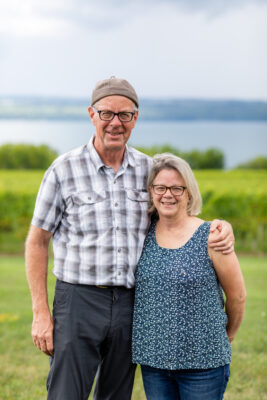
Something surprising happened at the 2023 New York Wine Classic competition. The top white wine was a 2022 Gewurztraminer, not a grape that the state is particularly known for unless you’re really into New York wine. And, it was a medium-dry Gewurztraminer, adding to the surprise.
But Bruce Murray, who co-owns Boundary Breaks in Lodi on Seneca Lake with his wife Diana Lyttle, isn’t surprised this particular bottle from his winery was so well received.
“I would say Gewurztraminer isn’t necessarily the number one wine on everyone’s list for top wines of any kind,” he says. “This wine, I think, stood out because it sort of was very much in line with what classic Alsatian, rich, highly developed, floral developed Gewurztraminers taste like.”
Murray thinks it’s interesting that from a region known more for its Rieslings and Cabernet Francs that a Gewurztraminer took the best white wine and a Blaufränkisch (from Keuka Spring Vineyards) took the best red out of all the submitted wines from the state.
“To be honest with you,” he says, “I don’t know how those decisions get made.” That’s not to say he doesn’t understand the parameters of the judging—he does.
For the competition, New York Wine & Grape Foundation partnered with the Beverage Testing Institute in Chicago, where a team of trained sensory panel tasters made up of beverage directors, sommeliers, top bartenders, retail buyers, and educators scored the 749 entries submitted by 108 wineries from across New York. Overall, BTI awarded a total of 10 Platinum, 320 Gold, 294 Silver, and 81 Bronze medals.
An Unusual Wine
Perhaps, he surmises, the wine won simply because winemaker Dave Breeden, who is also head winemaker at Sheldrake Point and has 20 years of experience in the Finger Lakes, made an excellent wine from a vintage that nurtured the grape in a certain way.
“In the case of this Gewurztraminer,” Murray says, “I think it’s a perfect benchmark example of what an Old World Alsatian Gewurztraminer is like, say from a producer like Zind-Humbrecht out of Alsace.”
He believes it’s a very unusual wine and the reason for that is twofold.
The first reason is the conditions during the winter of 2021-22. Frost and cold damage reduced yield on the mature vines and made it easier to ripen the fruit once it grew.
“Nature’s way of thinning fruit,” says Murray, “is to have a cold spell in the middle of winter in the Finger Lakes.”
The second reason for this unusual wine is that the 2022 growing season was very hot and very dry producing berries among all varieties that were smaller with concentrated juice.
“When you have very small berries and concentrated juice on an already reduced yield,” he says. “You have unusual Gewurztraminer [grapes] to start with.”
The grapes were picked at a very high Brix—23.5—and had the wine been fermented to completely dry, it would have had a 14.5% to 15% ABV. Hence, the off-dry style.
When the team at Boundary Breaks first tasted the wine from that unusual fruit, Murray recalls, “Everyone said this was an amazing wine.”
That amazing wine, Murray believes, will be ageable for a “good 25 years” and get earthier and more interesting as it does. He thinks its sweet spot will be when it’s 10 to 15 years old.

The Soil Helped, Too
“It’s a cliche,” says Murray, “that wine begins in the vineyard.”
But it’s not untrue. And Murray and the team at Boundary Breaks are serious about the health of the soil in the vineyards.
Instead of putting herbicides, fertilizers, and all kinds of additional materials into the ground, they minimize external inputs and maximize the basic health of the soils.
“This is not an organic model. This is not a biodynamic model,” he says, acknowledging they are not the only winery doing this. “This is sort of classic agricultural soil health. It starts with measuring organic matter in your soil and other micronutrients.”
What they’re doing is most often referred to as regenerative farming.
“We’ve done a lot of reading. We’re looking at what other folks are doing out in California. And this is all making sense to us,” he says.
He’d rather not pay agrochemical companies tens of thousands of dollars a year. The way to make sure his winery doesn’t have to do that is to adopt this different set of practices in the way it treats the soil. That includes no-till farming and cover crop management.
“It’s not the sexy part of wine in general,” he admits. “How many types of cover crops are you planting between your vines? When do you crimp them? This is farmer geek stuff.”
But the farmer geek stuff results in some really great wine, including the winning Gewurztraminer (that’s still available for sale in the winery’s tasting room)
“Awards are really nice,” says Murray, “And hats off to the New York Wine and Grape Foundation that’s done a great job in keeping this particular New Classic classic going. I really appreciate them. But in the end, people have to like your wine. We are never going to be finished trying to improve the quality of these wines and doing stuff that will take years to have an impact.”
In other words, the unsexy farmer geek stuff is working.

Boundary Breaks 2022 Gewürztraminer
- Pronunciation: guh-VERTZ-tra-meen-er
- Varietal: Gewurztraminer
- Appellation: Finger Lakes
Winemaker Notes: Gewürztraminer is a "cool climate" grape variety. That means the fruit retains its acidity through a long growing season all the way through harvest. The result is a rich, aromatic, food-friendly wine.
We harvest the fruit for this wine earlier than our Rieslings. That is because we want to ensure that grapes have enough acidity to produce a refreshing, clean bright wine. At this earlier level of ripening, the fruit has more minerality and spice and is less floral than fruit harvested later in the season. As a result, our Gewürztraminer is much more subtle and earthy than Gewürztraminers that exhibit strong notes of rose petals and perfume.

About the New York Wine Classic
Organized annually by the New York Wine & Grape Foundation, the New York Wine Classic celebrates a diverse selection of world-class wines from producers within the State. Judging for the 2023 competition took place from April 15th – June 15th, 2023 and included 749 entries from 108 wineries from across the state. A total of 10 Platinum, 320 Gold, 294 Silver, and 81 Bronze medals were awarded.

